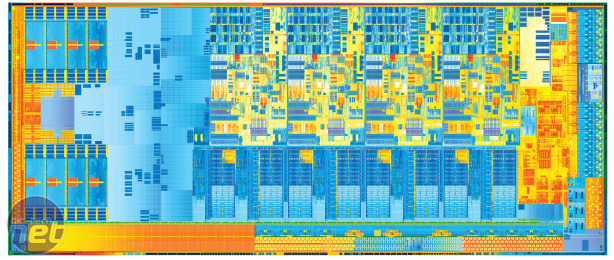
Performance Analysis
The improvements to the i7-3770K’s IPC (instructions per clock) are immediately apparent in Cinebench, where its score of 7.91 at its stock frequency of 3.5GHz (boosting to 3.9GHz) sees it achieve a five per cent increase over the i7-2600K it replaces. Here, the chip’s Hyper-threading really helps too, with a substantial advantage over the i5-3570K. However, the six-core Sandy Bridge E chips are still significantly faster, a pattern repeated in the WPrime scores.Moving to our real-world benchmarks (still graciously provided by our friends at Custom PC), we find the i7-3770K is an absolute monster. In the image editing portion of the test, its stock score of 1916 is higher than the £770 Intel Core i7-3960X Extreme Edition and a healthy 10 per cent higher than the i7-2600K in the same test. However, this test does not favour Hyper-threading, so the i5-3570K is close behind, and due to its superior overclock, surpasses the i7-3770K in this capacity.
In the video-encoding portion of the benchmark, the i7-3770K again performs extremely well, surpassing the six-core i7-990X Extreme Edition with a score of 3461. The addition of Hyper-threading again allows the i7-3770K to lead the i5-3570K at stock frequencies, but when both CPUs are overclocked the 3570K’s 200MHz advantage negates Hyper-threading and both CPUs perform similarly.
In the multi-tasking component of our tests, the i7-3770K again impresses, with a stock score of 1767, again beating the i7-3960X Extreme Edition at stock frequencies. The overall result sees the 3770K come in a fraction behind the six-core monster but it’s incredibly close. The i7-3770K’s overall score of 2403 is just 75 points (three per cent) off Intel’s top-end chip, although the i7-3960X Extreme Edition is faster when overclocked
When it comes to game performance, the i7-3770K again impressed. In ARMA 2 at stock frequencies its minimum frame rate of 100fps is the highest we’ve seen from any stock CPU, and when overclocked we were GPU limited at a minimum frame rate of 106fps, despite the use of a GeForce GTX 590 3GB.
The real surprise however came in the Shogun 2: Total War test, where the i7-3770K delivered huge improvements over its predecessor. This is likely the IPC and SSE optimisations at work, with a minimum frame rate of 29fps a 60 per cent increase over the i7-2600K. We were so amazed by this improvement that we went back and re-ran the Sandy Bridge results, only to find our numbers were right. Ivy Bridge really is that much faster in Shogun 2: Total War. However, the i5-3570K performs very similarly at stock, and when overclocked to 5GHz, comfortably surpassed the i7-3770K.
What's more, the move to a 22nm production process and the implementation of tri-gate transistors has allowed the i7- 3770K to be extremely frugal when it comes to power consumption. At stock speeds we saw an idle system power draw of just 99W, despite the use of the GeForce GTX 590 3GB. Under load this rose to 166W, 14W less than the i7-2600K, but still a little more than the i5-2500K. When overclocked to 4.8GHz, the idle power consumption rose slightly to 115W, while under load the system power consumption peaked at 244W. This is substantially less than the 313W required to push the i7-2600K to 5GHz.
Click to enlarge - Ivy Bridge looks set to continue Intel's dominance of the enthusiast market
Conclusion
Intel is in the enviable position of having the enthusiast CPU market all to itself right now. AMD’s competition is increasingly focused on the fusion of GPU and CPU, but this has come at the cost of raw CPU performance. For those who use a dedicated graphics card there’s only been one choice for months, and Ivy Bridge only underlines this.Minor performance improvements across the board in comparison to the previous generation of Sandy Bridge processors, a drop in power consumption and a like-for-like price make Ivy Bridge, without doubt, a worthwhile replacement, albeit not an earth-shattering one. If you opted for a Sandy Bridge CPU and its P67 or Z68 platform in the last year, there’s little reason to regret your purchase (unless you play lots of Shogun 2) and as such, no real reason to upgrade, especially if you’ve overclocked your CPU.
However, for new-builds and for those who skipped the Sandy Bridge last year it’s a simple choice: the i7-3770K is far, far quicker than an Intel Core i7-920 or any other preceding quad-core chip. It's also an absolute doddle to overclock to 4.4GHz and beyond. A decent Z77 motherboard requires you to literally only adjust the Vcore and multiplier to achieve stable overclocks. So long as you’ve got a cooler to keep up, clock speeds of 4.8GHz on air are perfectly achievable.
However, as you’ll no doubt have spotted throughout our performance graphs, the £160 i5-3570K is never far behind, and overclocks just as well (and in our case, better) than the i7-3770K. Here we see a case of history repeating itself: while the i7-3770K is faster at stock, the i5-3750K is far better value, and unless you’re making extensive use of applications that can take advantage of Hyper-threading such as rendering or video encoding, the i5-3750K is the better choice.
It’s the same dilemma that i7-2600K/i5-2500K buyers faced, and frankly, neither is wrong. Both represent a small, but meaningful step forward for Intel, and unless you require the brute power of the much more expensive X79 platform, offer all the performance you could need.

-
Value26 / 35
-
Features14 / 15
-
Performance45 / 50


MSI MPG Velox 100R Chassis Review
October 14 2021 | 15:04









Want to comment? Please log in.